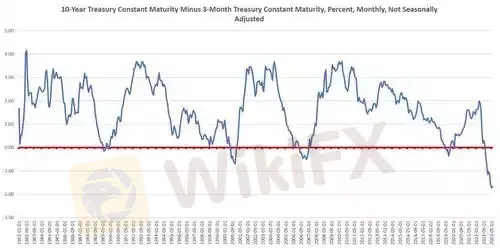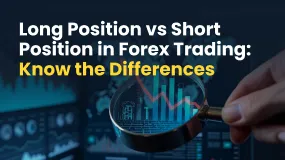Deepest US Yield Curve Inversion in 42 yrs portends Recession Dead Ahead
Abstract:Last week, the US Treasury yield curve, a reliable indicator of recession, experienced its steepest inversion since 1981. This coincided with one of the most severe downturns in Bloomberg’s US Economic Surprise Index in recent memory.

Last week, the US Treasury yield curve, a reliable indicator of recession, experienced its steepest inversion since 1981. This coincided with one of the most severe downturns in Bloombergs US Economic Surprise Index in recent memory. Meanwhile, Moody's reported that corporate debt defaults in the US in July surpassed the total for last year. Despite these indicators and record low unemployment rates, the stock market rally, often referred to as the 'most hated', continues almost unhindered, while the price of gold remains stable.
First, the chart below is for the common 10yr / 3month US Treasury yield spread since 1982:

Looking back to the last 2 times the yield curve was as inverted as now, we need to see the Great Depression of 1929 and 1980, the latter considered the worst since WW2.

You will note the uncanny knack it has of predicting practically every recession. For those looking closely, yes it inverted mid 2019 but the literally unprecedented amount of liquidity pumped into the system by the Fed during COVID masked what many, and indeed most, economists were predicting to be a recession on fundamentals. You will also note recessions don‘t immediately follow the inversion but rather there is a lag of around a year before recession hits. Looking back too, you will see nearly every recession is preceded by a low in unemployment, so the low unemployment number in the US now is not a ’this time is different indicator, but the norm. What it means though, is the Fed will be, and has outright stated, hesitant to hold let alone cut rates whilst unemployment is so low and threatens wage inflation.
And so the tug of war continues for our hapless Fed who have also, near perfectly, hiked into a recession each time. Last week‘s Bloomberg’s US Economic Surprise Index was a shocker as things turned worse than analysts predicted against a whole basked of economic metrics. Indeed it was the worst turn since… you guessed it… 2019.

As mentioned above Moodys came out reporting a surge in bankruptcies as companies who borrowed on cheap rates now have higher repayments and banks getting tougher:
“Banks are battening down the hatches, hogging their bailout money instead of lending it out,” said Pete St. Onge, a Heritage Foundation economist, in a recent podcast.
“That credit crunch means not only do we get bankruptcies like in any recession, on top of that, we get a lending wall that cuts off even the healthy businesses. Of course, their jobs go down with them.”
The stock market, particularly NASDAQ (which we primarily focus on here), is currently experiencing a surge. This boost is driven by the expectation that the Federal Reserve will soon intervene with further quantitative easing and rate cuts. The beneficial effect on the gold price of such actions from the Fed is well understood. However, until such steps are taken, gold remains a stable investment. It serves as a safe haven, a protective measure or insurance for those investing heavily in equities in case the yield curve inversion once again turns out to be accurate.

Read more

Thailand Seizes $318 Million in Assets, Issues 42 Arrest Warrants in Major Scams Crackdown
Thailand has intensified its fight against regional scam networks, seizing more than $318 million in assets and issuing 42 arrest warrants in one of the country’s most sweeping anti-fraud operations to date, authorities announced on Wednesday.

Community Limited-Time New Year Wishes Event
Dear friends, 2025 is coming to a close, filled with stories, while 2026 approaches with infinite possibilities. Thank you for another year of companionship. The community has specially launched this New Year Wishing Pool for you.

【WikiEXPO Global Expert Interviews】Ghadeer Ibrahim: Responsible Media Perspective
As WikiEXPO Dubai concludes successfully, we had the pleasure of interviewing Ghadeer Ibrahim, the Market Analyst & CNBC Arabia Economic Editor. Ghadeer Ibrahim has over ten years of experience in the forex market as a market analyst. Throughout her career, she has conducted numerous educational seminars across the Middle East and appeared on several regional media outlets. She currently works as an economic editor and program producer at CNBC Arabia, where she covers key developments in global markets and economic trends.

Long Position vs Short Position in Forex Trading: Know the Differences
When investing through forex, you often come across terms such as long position and short position. You may wonder what these two mean and how they impact your trading experience. So, the key lies in understanding the very crux of this forex trading aspect, as one wrong step can put you behind in your trading journey. Keeping these things in mind, we have prepared a guide to long position vs short position forex trading. Keep reading!
WikiFX Broker
Latest News
Plus500 Allegations Exposed in Real Trader Cases
November private payrolls unexpectedly fell by 32,000, led by steep small business job cuts, ADP reports
US Industrial Production Sees Biggest Annual Gain In 3 Years Despite Slowing Capacity Utilization
HEADWAY: The Fast Track to Financial Dead-Ends?
Polymarket Launches First U.S. Mobile App After Securing CFTC Approval
Thailand Seizes $318 Million in Assets, Issues 42 Arrest Warrants in Major Scams Crackdown
RM460,000 Gone: TikTok Scam Wipes Out Ex-Accountant’s Savings
The "Balance Correction" Trap: Uncovering the Disappearing Funds at Vittaverse
Adam Capitals Review 2025: A Detailed Look at an Unregulated Broker
NordFX.com Review Reveals its Hidden Negative Side- Must-Read Before You Trade
Rate Calc


